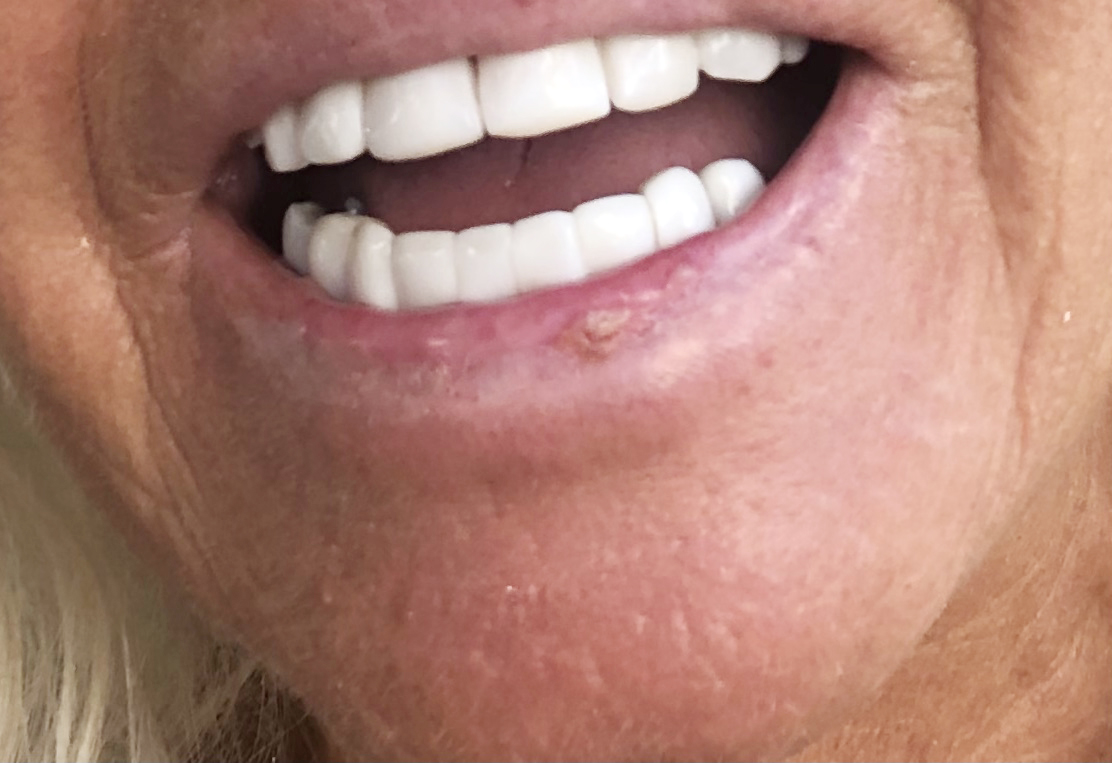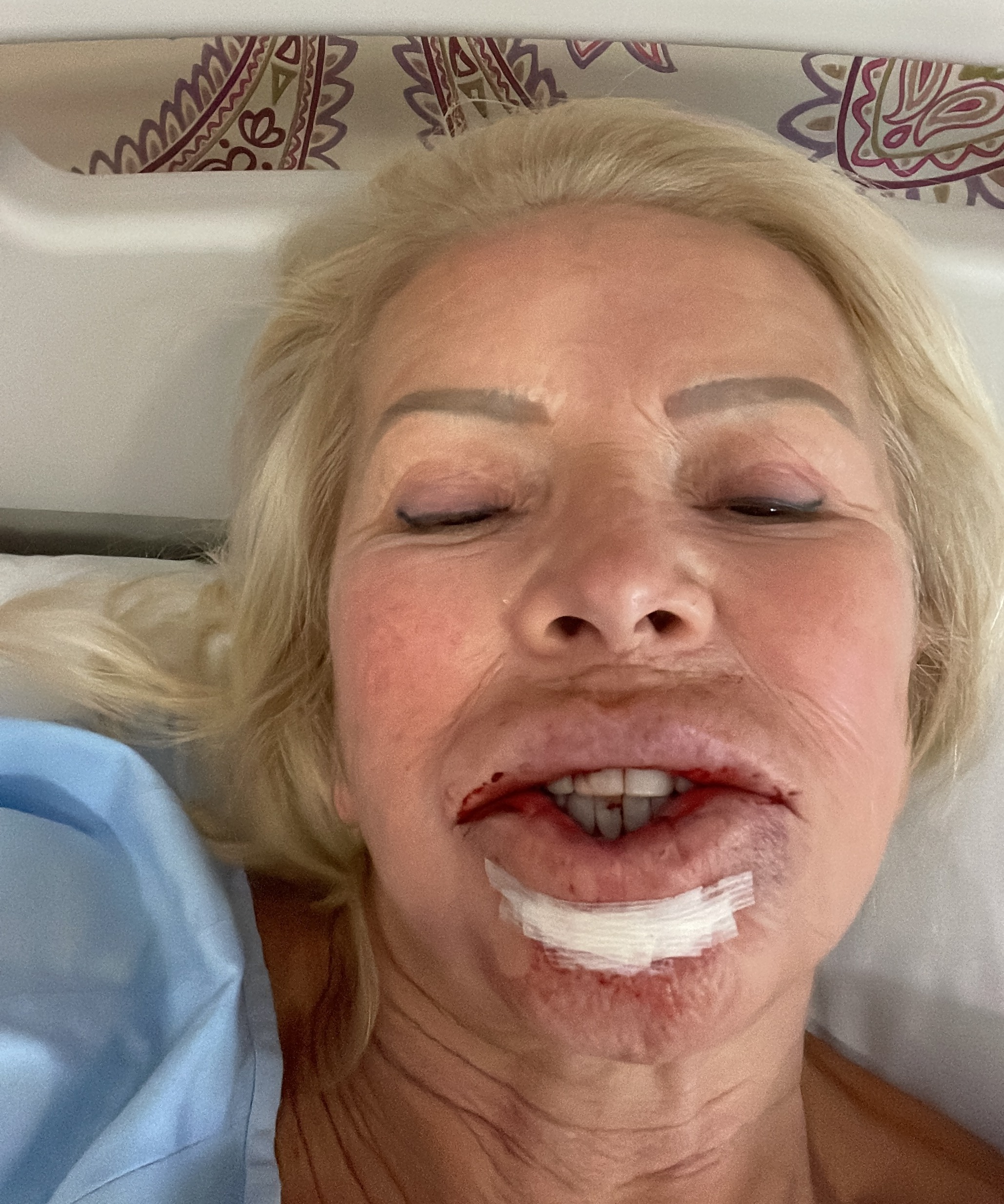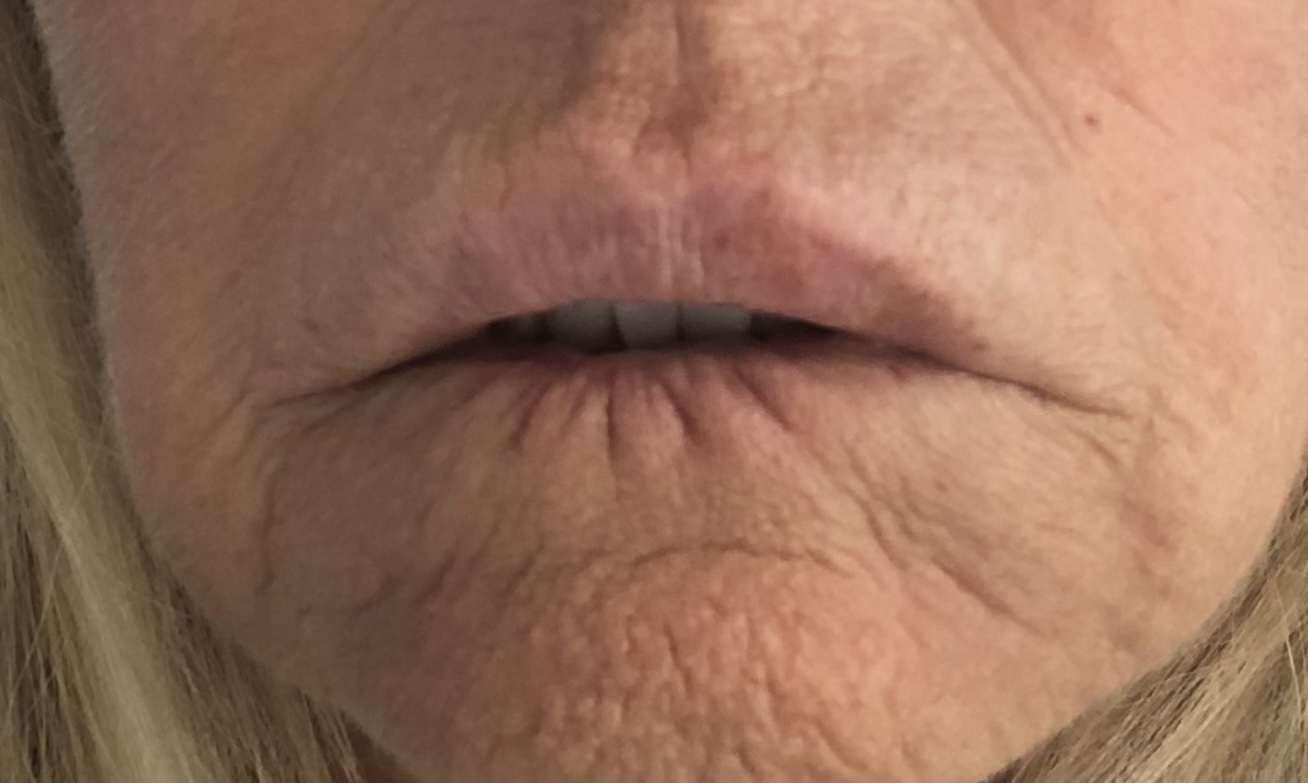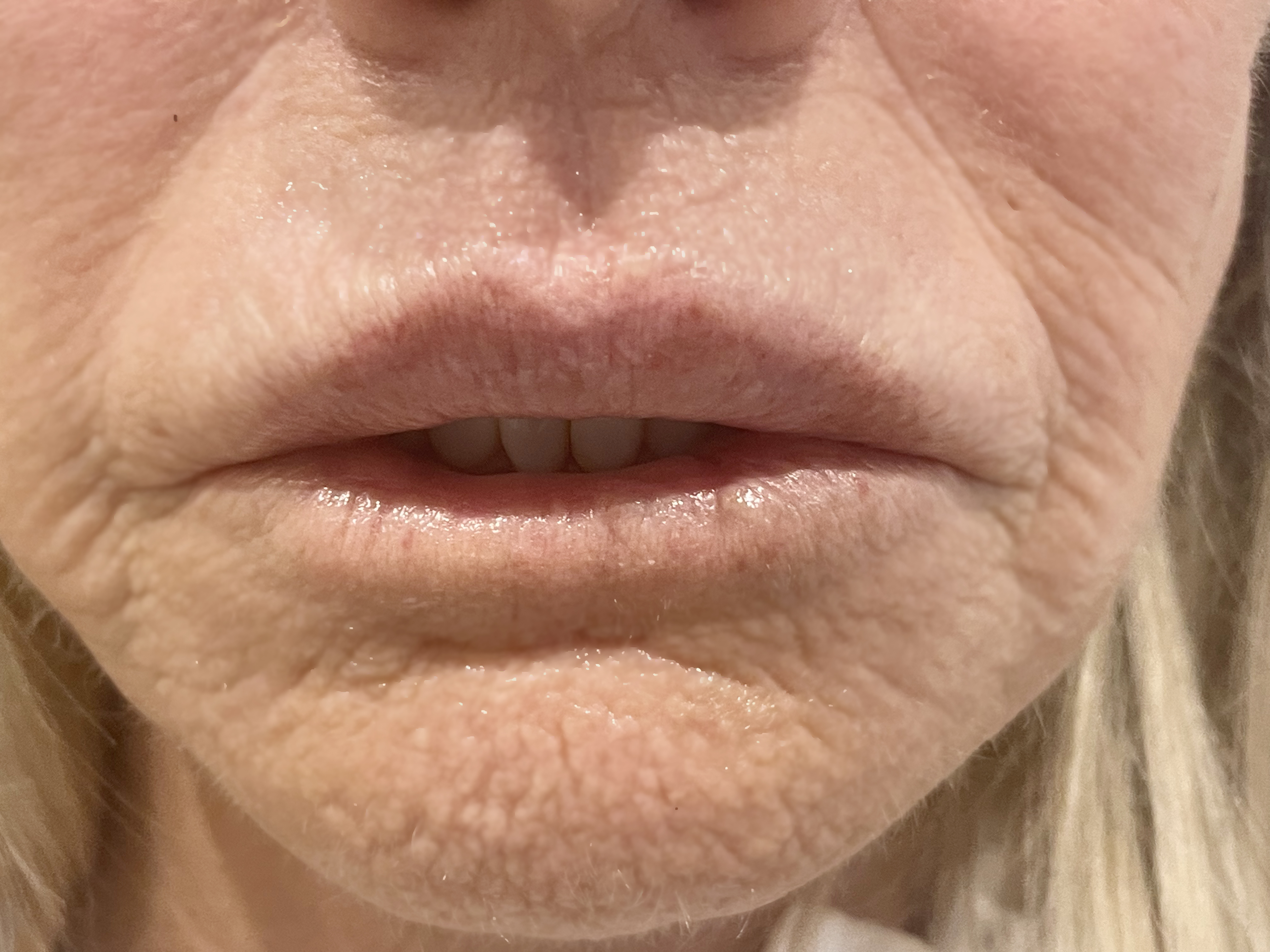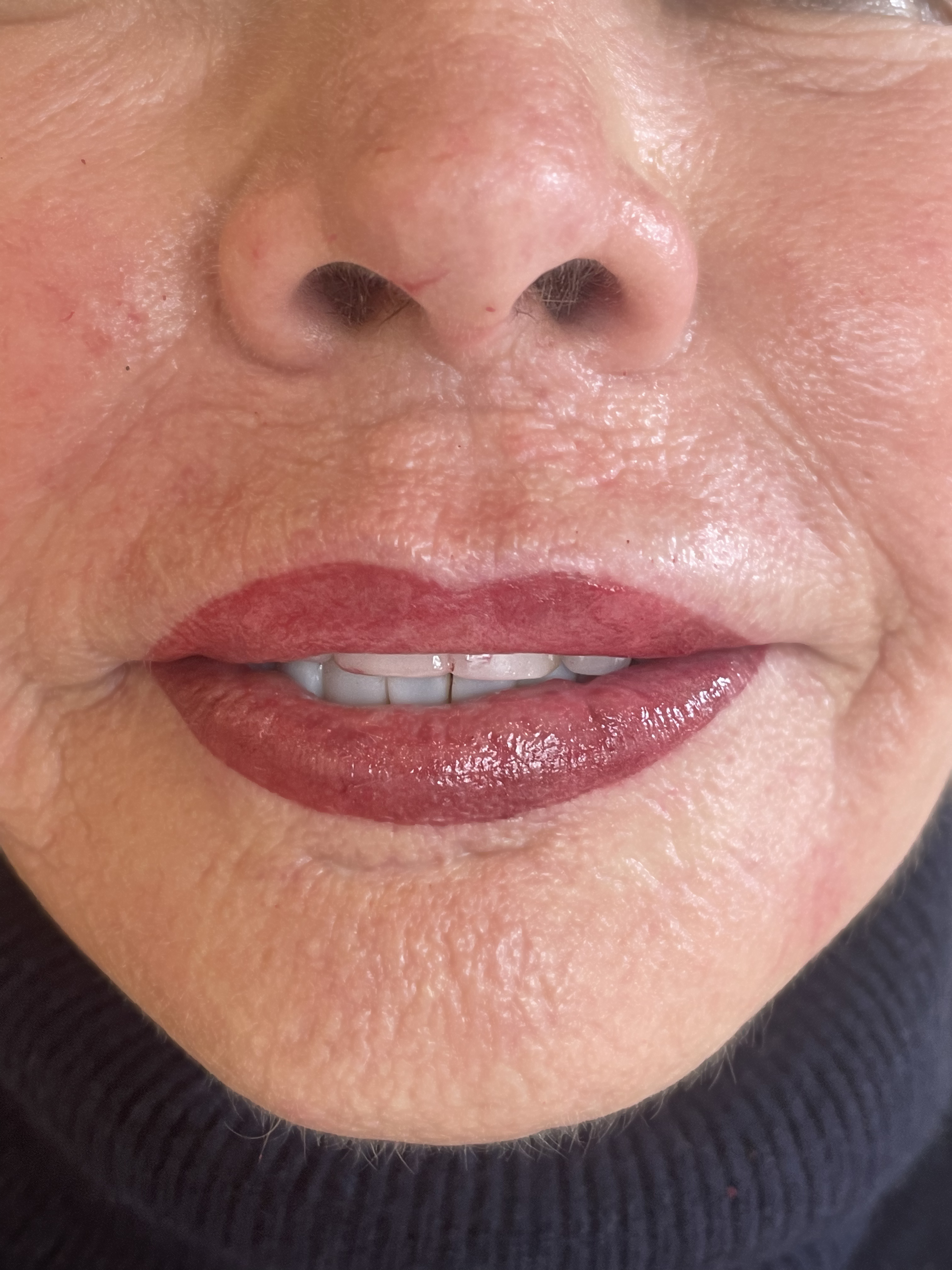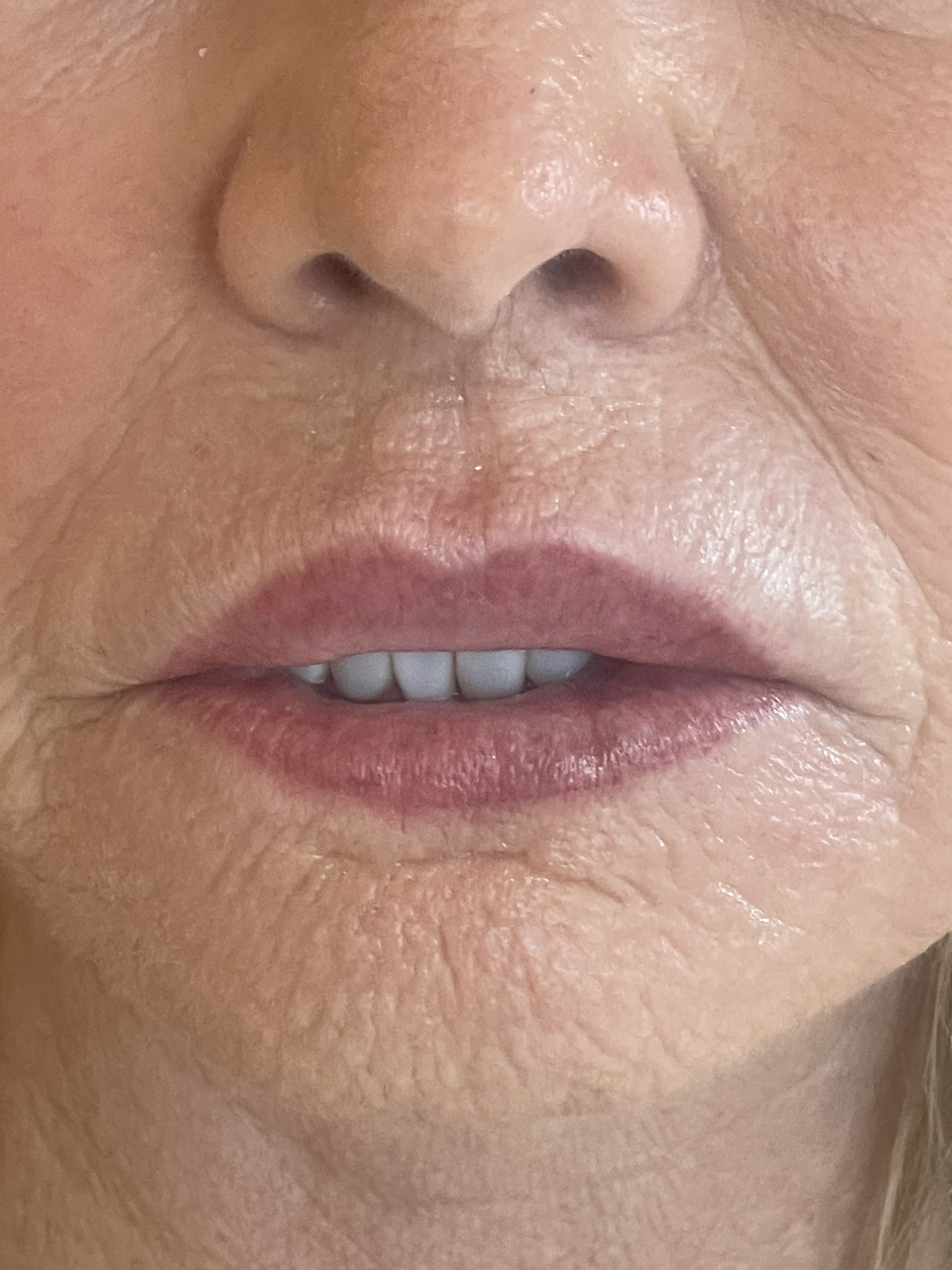WHEN PAULINE first noticed a dry spot on her bottom lip, she thought it was a cold sore.
But after months of painful treatments, the 64-year-old was given the terrifying news that the blistered growth on her lip was in fact cancer.
Pauline was diagnosed with squamous cell carcinoma (SCC), which – according to consultant dermatologist and British Skin Foundation spokesperson Dr Penelope Pratsou – “is the second most common skin cancer seen in the UK”.
It occurs as a result of DNA damage to the keratinocytes, the skin cells on the top surface of the skin, Dr Pratsou told Sun Health.
Though non-melanoma cancers – which include SCC and basal cell carcinoma – are considered less dangerous than melanoma, recent research has shown that non-melanomas now kill more people worldwide as they’re so common.
Most SCC cases are caused by cumulative exposure to ultraviolet light, which comes from the sun or sunbeds.
Other risk factors include smoking, having fair skin or having a suppressed immune system from medical treatment or disease.
But tumours can also emerge from old scars, burns or chronic wounds such as ulcers, Dr Pratsou told Sun Health.
Pauline was told her cancer could have been caused by sun exposure.
But the mum-of-three claims doctors also said there was a chance her tumour could have been caused by a lip filler treatment.
A ‘strange material’
Pauline first noticed a dry spot on her bottom lip at the end of August 2020, when she took a photograph of herself to send to her son after having her teeth whitened.
“I thought it was a cold sore,” Pauline told Sun Health. “But when I look back at those pictures that I sent to my son, you can see that was the start.
“It was showing on the outside but obviously it was already growing on the inside, unknown to me.”
Pauline and her husband were living in Alicante, Spain at the time. By September 2020, she realised that the sore wasn’t healing and booked an appointment with her local doctor.
Seeing no result from the creams she was prescribed, Pauline was referred to a dermatologist, who treated the sore by trying to burn it off.
After repeated visits to his clinic, Pauline noticed her lip was turning black and woke up each morning with her bed linen ‘covered in blood’.
Her dermatologist took a biopsy of the sore in November 2020. After three weeks, she received the devastating news that she had cancer.
“It was the first time in seven years all three of our sons were in Spain with us and I didn’t want to go home and tell them,” she said.
The biopsy revealed that the cancer in her lip had spread down to her chin – she was told it needed to be surgically removed straight away.
The dermatologist advised Pauline she’d have to have her ‘whole chin’ removed in order to get rid of it and wanted to operate immediately.
But Pauline recalled thinking: “This is my face, I’ve got to wait, I need to do some investigation.”
Pauline was referred to a surgeon, Dr Carlos Laredo, who suggested using Pauline’s tongue to reconstruct her lip, as the tumour lay deeper than initially thought.
It was Dr Laredo, who officially diagnosed Pauline with SCC.
Her biopsy also uncovered “a strange material” at the bottom of the tumour, which she said doctors “likened to lip filler”.
‘I just went black and blue’
Pauline had had filler injected into her lips four times while living in England – but only ever to her top lip, to give it some definition.
In Spain, she decided to try a ‘no-needle’ lip plumping method on the recommendation of an acquaintance, who said it was less painful than having it done with a needle.
Typical lip filler treatments use either needles or cannulas to inject specially developed hyaluronic acid gels deep into the lips – giving them volume and shape.
In contrast, the ‘no-needle’ method uses compressed air in a pen to push hyaluronic acid through the top layer of skin into the deeper tissue, according to Dr Toni Phillips, clinical director at SK:N Group.
“This method uses ‘nanojet’ delivery technology which has been around for about 20 years,” she explained.
Dr Phillips told Sun Health the technology is most commonly used to painlessly administer dental anaesthetic and to help diabetics get their daily insulin without having to use a needle to inject themselves.
But she stressed the pens are not licensed to be used for filler in the UK – “which is why many qualified medical aesthetic injectors haven’t adopted this method to perform lip filler treatments”.
Pauline said she found the no-needle treatment agonising.
“It was more painful for me, I’d rather have had the needle,” she said, adding it felt like she was being “punched in the mouth”.
“It’s a pen and they put it on your lips and it kind of thumps [filler] into your lip. I just went black and blue really quickly. The nurse doing the procedure said, ‘We’re going to have to stop’.”
SCC is skin cancer, so Pauline said Dr Laredo couldn’t rule out her tumour was caused by the sun.
“But I was told there was also a chance it was caused by lip filler, as right in the bottom of the tumour there was a substance that they were certain was filler, ” she claimed.
‘No evidence’ linking traditional lip filler with cancer
Dr Phillips said the lack of safety data for ‘no needle’ treatments for the lips is a great concern.
“At the moment, I’m not aware of any data over the last 30 years showing a direct correlation between using lip fillers – injected with widely studied techniques like a needle or cannula – and cancer,” she said.
She added that “whilst we can never completely rule anything out, as medical professionals we are constantly reviewing safety data and best practise”.
“However, we do not have this wealth of safety data for the ‘no needle’ method for lip treatments so I cannot comment on the cancer-causing risks of this technique, but I can confidently say that I will never use it in my clinical practice,” the dermatology expert went on.
“The ‘no-needle’ technique can only deliver the hyaluronic acid into the epidermis and as a result, the hyaluron pen could cause lasting damage as it uses high pressure jet technology.
“Other potential side effects could include bacterial or fungal infection, severe inflammation and irritation due to the very superficial placement in the epidermis and delayed healing if infection occurs.
“What’s more, if the hyaluron pen is shared between clients, there is a risk of cross-contamination and therefore the spread of transmissible infections, such as herpes.”
Though normal lip filler treatments also carry risks – such as bleeding, bruising or pain at the injection sites, infection, tenderness, swelling and sometimes lumps or bumps developing – they “are usually very safe when performed by a properly qualified medical practitioner”, Dr Phillips added.
Dr Pratsou echoed Dr Phillips in saying: “There are no reported cases in the literature of squamous cell carcinoma arising as a consequence of hyaluronic acid filler.”
But she advised against opting for the ‘no-needle’ technique.
“It is thought to pose several risks including incorrect and difficult to control filler placement, infections, skin wounds and, in some occasions, even skin necrosis.”
Ashton Collins, director of the government-approved register for medical aesthetic treatments Save Face, told Sun Health: “Whilst this is a treatment we do not recommend and indeed it has been banned in some countries, there is no evidence to support the treatment being linked to cancer.
“Hyaluronic acid has been widely used in medicine and in aesthetics for many decades now with no reports of cancer.”
She added Pauline’s cancer was “most likely to be coincidental”.
‘My tongue was sliced sideways and sewn to my lip’
Though Pauline now says her invasive surgery was a small price to for her life, she couldn’t have foreseen how arduous the next two years would be.
After removing the growth in Pauline’s lip, Dr Laredo sliced her tongue lengthwise and sewed the two flaps to her lip.
“I was like that for three weeks, where I could just drink fluids with a straw, that was it,” she recalled.
“I’d wake up during the night and [realise] I’d bit my tongue. And that was so painful, it was unbelievable.”
In January 2021, once her tongue tissue had fused to where her bottom lip used to be, Pauline’s surgeon severed it and ‘folded the two flaps to fill up’ the space left by the tumour, grafting a new lip out of her tongue.
The full healing process took between 12 and 14 months.
‘I didn’t want to see people’
Because the tumour had run so deep into Pauline’s lip, her bottom teeth were left permanently exposed after her surgery.
Dr Laredo used a variety of methods to re-plump up her lower lip, but refused to use any artificial filler.
The fat he injected into her lip kept being absorbed into her body, so he used breast tissue instead, which stayed put.
Much of Pauline’s ordeal happened during the pandemic, when mask wearing was the norm.
She said: “It didn’t affect my self-confidence too much because everyone was wearing masks, so I wasn’t self conscious and I could hide behind my mask.”
But when Pauline returned to England in November 2022, where people had very much shed their face coverings, she was anxious meeting up with old friends.
Now based in Shrewsbury, on the Welsh border, Pauline remembered: “I realised I didn’t want to see people. I was withdrawing from everyone because nobody was wearing masks.
“I would find myself with my hand in front of my face and I was just self conscious of it. I didn’t want to bump into people I knew.”
Pauline said her surgeon ‘had taken it as far as he could’ with reshaping her lip, but she felt self-conscious that it lacked definition and was the same colour as the rest of her face.
‘Medical tattooist gave me my confidence back’
That’s when she reached out to Karen Betts, a renowned medical tattooer and permanent makeup artist, who treated the likes of Katie Piper following her acid attack, and Alex Lewis, who suffered severe facial disfigurement and a quadruple amputation following a strep A infection in 2013.
Karen took up medical tattooing to help a friend going through cancer who lost her hair and had a double mastectomy, tattooing her eyebrows and areolas. Since then, she’s opened three clinics across the UK.
Pauline herself had trained in semi-permanent makeup years ago when she had her own clinic and had wanted to train under Karen.
Karen has tattooed a whole range of patients – from people who’ve lost their eyebrows to alopecia or cancer treatment, to burn victims, or those who’d like to get their features touched up for cosmetic reasons.
But she told Sun Health: “It’s the first time I’ve come up against anybody having cancer in their lip.”
After discussing the colour and shape Pauline was looking for – she even brought a favourite lip pencil as a reference – Karen set about giving Pauline her confidence back.
Karen was unsure about how Pauline’s reconstructed lower lip would take on colour. To her surprise, the pigment “took brilliantly, even on the first session”, Karen told Sun Health.
Being mindful that Pauline wouldn’t have used to seeing lip colour on her face, Karen slowly built up the pigment over three sessions.
“She’s done a great job,” Pauline said about Karen’s work. “I’m so pleased with what she’s done.”
Pauline still sometimes feels self conscious when talking – but her confidence has grown in leaps and bounds since getting her lips tattooed.
She expects she’ll have to get her lips topped up every year to a year and a half.
‘We all think it won’t happen to us’
Recalling the past three years of her life, Pauline said it was “a pretty horrendous thing to go through”.
Not being able to talk to anyone else with a similar experience was isolating, she recalled.
“There was nobody for me to [ask]: ‘How long did you have to wait? What did you do, how did you cope with it?’ I hadn’t got anyone to talk to about it, nobody had gone through it.”
All of the tumour was removed and she didn’t have ‘any radiation’, she said – but she still gets a little paranoid sitting in the sun.
“It could have all been so much worse. I hope that is the end of it and there’s no more to come.”
Pauline was compelled to share her story in the hopes that no one else will have to go through what she has, saying: “I wouldn’t wish it on my worst enemy.”
She added. “We all think it won’t happen to us.
“I’ve been really lucky that I got it as quickly as I did. And I could afford to go private and have all of this done.
“I consider myself so fortunate, but it could have been very different.”
She pointed out that it’s rare for people to consider the possible risks of getting filler when they have a treatment.
“My advice to people would be think about why you’re doing it and who you’re doing it for.”
Pauline stated: “I’ve got three sons, but If I had a daughter, I certainly wouldn’t be going along with her to have her lips done.”
Sun Health has sought comment from a number of aesthetic medicine trade bodies.
What is squamous cell carcinoma?
Squamous cell carcinoma is a non-melanoma skin cancer – a type of cancer that starts on the top layer of the skin.
It appears as a firm pink lump with a rough or crusted surface. There can even be a spiky horn sticking up from the surface, according to the NHS.
The lump often feels tender when touched, bleeds easily and may develop into an ulcer.
There can sometimes be considerable skin damage if the tumour is not treated. The early you identify and treat it, the better.
Any part of your skin can be affected, but it’s most common in areas exposed to the sun, such as the:
- head, face and ears
- neck and shoulders
- back
- hands
- lower legs
There’s a very small risk of squamous cell carcinoma spreading to other parts of the body, such as the lymph nodes – these are small glands found throughout your body.
You should see your GP if:
- you have a growth on your skin that’s getting bigger or has changed colour or texture
- you have a growth or area of skin that hurts, itches, bleeds, crusts or scabs for more than four weeks
Source: NHS


